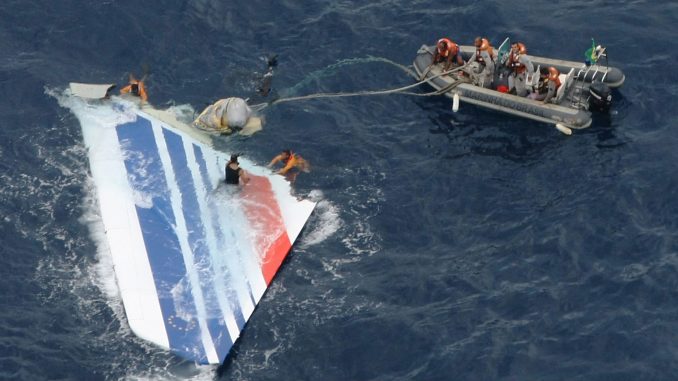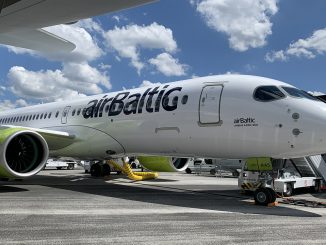
This was the photo taken on June 8th 2009 which depicts rescue workers removing the vertical stabiliser from of the Atlantic ocean. It serves as a lasting reminder of the loss Air France flight AF447.
The beginning
On May 30th, 2009, Air France flight AF446 departed Paris Charles de Gaulle for Rio de Janeiro where it landed approximately 10 and a half hours later after an uneventful night. The Airbus A330-200 (F-GZCP) was then parked for the day before being prepared for the return flight to Paris, which was set to depart at 19:00h local time / 22:00h UTC.
216 passengers and 12 crew members were on board the Airbus A330. Of those on board, most were Brazilian or French, alongside people from over 30 more nations.
At 22:09h UTC, the flight crew consisting of a 58-year old captain, a 37-year old senior first officer and 32-year old first officer, asked Air Traffic Control for clearance to start the engines and to start pushback. This clearance was given and 20 minutes later at 22:29h UTC, Air France flight AF447 was cleared for takeoff.
After takeoff, one of the first officers took a break in the rest compartment where he spent the next three hours before being woken up by the captain. After briefing the first officer, the captain then headed off to get some rest with the senior first officer occupying his seat and the first officer sitting next to him.
Minutes later the aircraft entered a large thunderstorm cell and the pilots turned on the seatbelt signs. While flying through the storm cell the aircraft’s pitot tubes, responsible for measuring the speed of the aircraft, clogged up with ice sending unreliable data to the cockpit.
The accident sequence
As a result the autopilot and autothrust (managing the thrust of the engine) disengaged at 02:10:05h, 3 hours and 40 minutes after takeoff. The senior first officer immediately stated “I have control” and started to correct the plane’s attitude. Because the autopilot disengaged due to receiving conflicting information from the frozen pitots, the flight computers had switched into alternate law. This means that the ‘top’ layer of protection from the fly-by-wire system is disabled. As a result, the pilot overcorrected the manoeuvres of the aircraft.
He then continued to do so for at least the next 30 seconds, before he pulled the side stick back to increase pitch, causing a brief stall warning and the air speed to decrease to 52 knots, down from 274 knots. By this time, the aircraft was climbing at over 7000 feet per minute. An aircraft like an A330 would take-off and climb at a maximum rate of between 1,800 and 2,500 feet per minute under normal operating conditions.
During this initial upset, the pitot tubes seemed to clear up and the plane was almost level flying but the pilots continued to make control inputs and at reaching 38000 feet, the engines were at maximum thrust with an excessive pitch up. The first officer then took over the controls and the aircraft began to stall. While the first officer pushed forward his side stick, the senior first officer bulled it back, overriding each other’s inputs.
In the meantime, the first officer called the captain back to the cockpit. For the rest of the flight, the plane was falling out of the sky with the senior first officer and the first officer having lost complete situational awareness since their intstruments and warning systems were unreliable. The captain then realised that the senior first officer was causing the plane to stall by continuously pulling back on the side stick.
Bt this point, it was too late to recover from the stall. The aircraft impacted the Atlantic ocean at 02:14:28h UTC, descending at over 10,000 feet per minute and a ground speed of 108 knots. Everyone on board was killed.
Over the next few hours, numerous attempts to call AF447 from ATC in Brazil and Senegal were unsuccessful, and search and rescue missions were started from both sides of the Atlantic. Air France notified French investigators at 07:45h UTC about the missing flight, bringing in their crisis intervention team into action and set up a hotline for relatives.
Recovery and investigation
The first wreckage of AF447 was spotted on 3rd June and the first bodies were recovered hours later. On June 8th, the above mentioned famous picture was taken and it wasn’t until 2 years later, when on May 2nd 2011, that the flight data recorders of AF447 were recovered from the ocean floor.
The subsequent investigation was completed on July 5th 2012, stating the cause of the accident as:
…inconsistency between the measured airspeeds, likely following the obstruction of the Pitot probes by ice…
…in addition to several crew errors on the side of detecting the fault, identifying their situation and recovering from it.
In Addition to that, it was also found that the pitot tubes used on the A330 were affected by an Airworthiness Directive, challenging the carrier to replace the pitot tubes as they can malfunction in flight should they become contaminated in flight. Air France was already in the process of replacing the affected pitot tubes, but the pilot’s unions wanted to accelerate the replacement stating that an accident is waiting to happen if they continue to fly with these faulty pitot tubes.
Tragically, F-GZCP was due to get its pitot tubes replaced on June 1st after arriving at Paris CDG as AF447.
Jan-Hendrik is an aviation enthusiast from Germany, loves to travel the world and fly on as many aircraft as possible. His first flight was with a Condor 757 to Spain and has been interested in aviation ever since. His fields of expertise are aircraft accidents and passenger experience (PaxEx).



